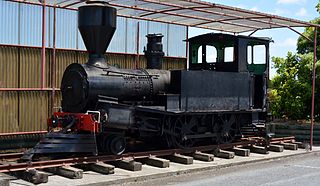
Helensville railway station formerly served the town of Helensville, 60.47 km (37.57 mi) northwest of Auckland Strand, in the North Island of New Zealand. It was a stop on the North Auckland Line, and was the next major station north of Waitākere. Occasionally it was called the Helensville North Railway Station.

Longburn railway station was a station in Longburn, on the North Island Main Trunk in New Zealand. The platform, which is across from the Fonterra Factory, remains but the structure has been demolished.

Otorohanga railway station serves the town of Ōtorohanga, on the North Island Main Trunk in New Zealand. The current station dates from 1924.

Te Kuiti railway station is a station on the North Island Main Trunk in New Zealand. The station was important in the growth of Te Kūiti.
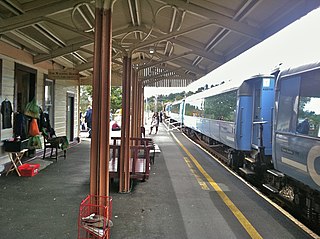
Ohakune railway station is a station on the North Island Main Trunk (NIMT), which serves the town of Ohakune in the Manawatū-Whanganui region of New Zealand. It is served by KiwiRail's Northern Explorer long distance train between Wellington and Auckland. It was called Ohakune Junction from 10 August 1926 until Raetihi Branch closed in 1968, to avoid confusion with Ohakune Town station on that branch. It was the second highest operating railway station in New Zealand, after National Park.

Feilding railway station was a station on the North Island Main Trunk line in Feilding, New Zealand. It was opened on 1 October 1876 and closed on 25 June 2012. The station is now used by Feilding Information Centre and an occasional excursion train.

Marton railway station was a station and rail junction on the Marton–New Plymouth Line, opened on 4 February 1878. After the North Island Main Trunk (NIMT) made a junction to the south of Marton, a new station was built there and the old station renamed and downgraded, in 1898.
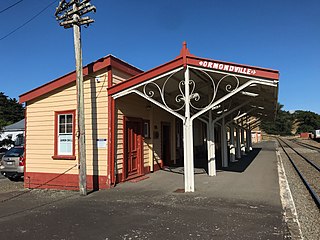
Ormondville is a locality in the Manawatū-Whanganui region of New Zealand's North Island. It is located inland, south of Waipukurau and west of Flemington, Hawke's Bay.
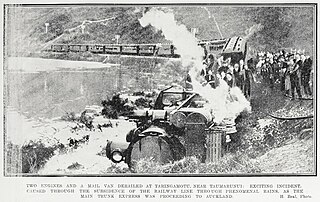
Taringamotu railway station was a station at Taringamotu on the North Island Main Trunk, in the Ruapehu District and Manawatū-Whanganui region.

Raurimu railway station was a station on the North Island Main Trunk, and in the Manawatū-Whanganui region.

Manunui station was on the North Island Main Trunk line, in the Ruapehu District of New Zealand, serving Manunui. It was 2.9 km (1.8 mi) south east of Matapuna and 4.63 km (2.88 mi) north of Piriaka. Freight was handled from 2 September 1904, though it wasn't until 16 September 1908 that it was listed as having a station yard, formation and fencing and 10 November 1908, when it was described as a 6th class station, with passenger platform, urinals, cart approach, a 30 ft (9.1 m) x 20 ft (6.1 m) goods shed and loading bank. On 24 July 1913 a request for lighting was added. A passing loop originally provided for trains of up to 26 wagons, but was extended to 100 in 1970 and 123 in 1980. By then Caltex had a siding for 11 wagons and a fertiliser store for 15.
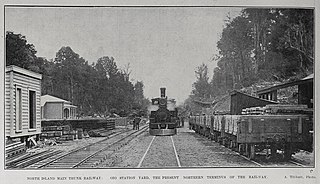
Oio was a station on the North Island Main Trunk line, in the Ruapehu District of New Zealand. It served the hamlet of Oio, which lay to the north of the station. It was 8.29 km (5.15 mi) north of Raurimu and 5.64 km (3.50 mi) south of Ōwhango. It was one of the many temporary railheads along the route, with work going on from 1904 to 1908.

Hīhītahi was a station on the North Island Main Trunk line, in the Rangitikei District of New Zealand, in the Hautapu River valley. The station served the settlement of Hīhītahi, which was big enough to have a store and a school. It was 12.55 km (7.80 mi) south of Waiouru and 3.05 km (1.90 mi) north of Turangarere. Hīhītahi is at the top of a 1 in 70 gradient from Mataroa, so that it is 39 m (128 ft) above Turangarere, but only 73 m (240 ft) below the much more distant Waiouru. A crossing loop remains.

Tangiwai was a station on the North Island Main Trunk line, in the Ruapehu District of New Zealand. The station served the settlement of Tangiwai. The nearby pulp and saw mills are now one of the main sources of freight on NIMT. In 1953 the Tangiwai disaster occurred when the nearby bridge over the Whangaehu River was swept away.

Karioi was a station on the North Island Main Trunk line, in the Ruapehu District of New Zealand. A passing loop remains.

Rangataua was a station on the North Island Main Trunk line, in the Ruapehu District of New Zealand. Like most of the stations on the central part of the NIMT, a large timber trade exploited the native bush until it was largely felled. What is now the small village of Rangataua developed to the south of the station. Just a single track now passes through and virtually nothing remains of the once busy station and workshops.

Horopito was a station on the North Island Main Trunk line, in the Ruapehu District of New Zealand. It served the small village of Horopito and lies just to the north of two of the five largest NIMT viaducts. It and Pokaka also lay to the south of Makatote Viaduct, the late completion of which held up opening of the station.

Erua was a station on the North Island Main Trunk line, in the Ruapehu District of New Zealand. It served the small village of Erua. For a month in 1908 it was the terminus of the line from Auckland. Makatote Viaduct and tramway are about 3 mi (4.8 km) south of Erua.
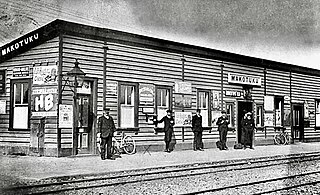
Makotuku is a locality in the Manawatu-Whanganui Region of New Zealand's North Island, about 3 km2 (1.2 sq mi) west of Ormondville.

Whanganui had three railway stations -





















